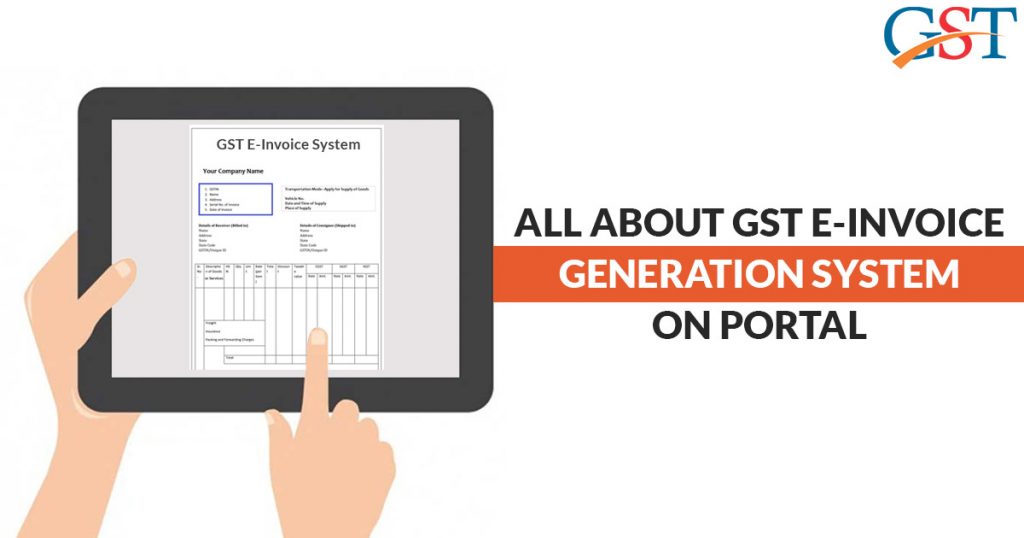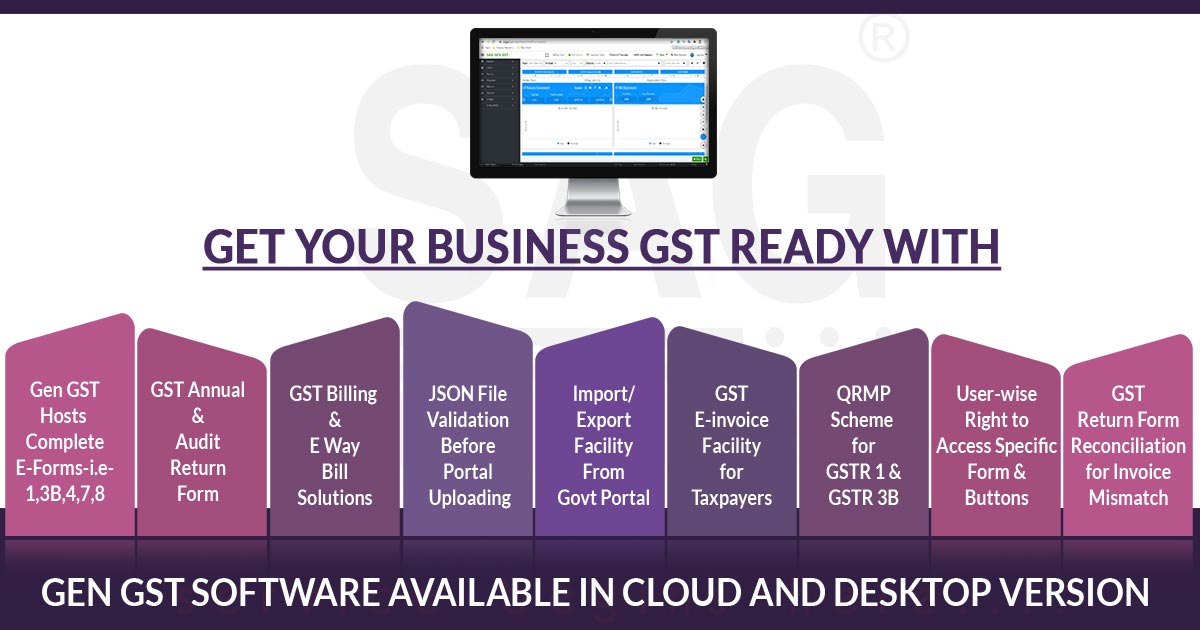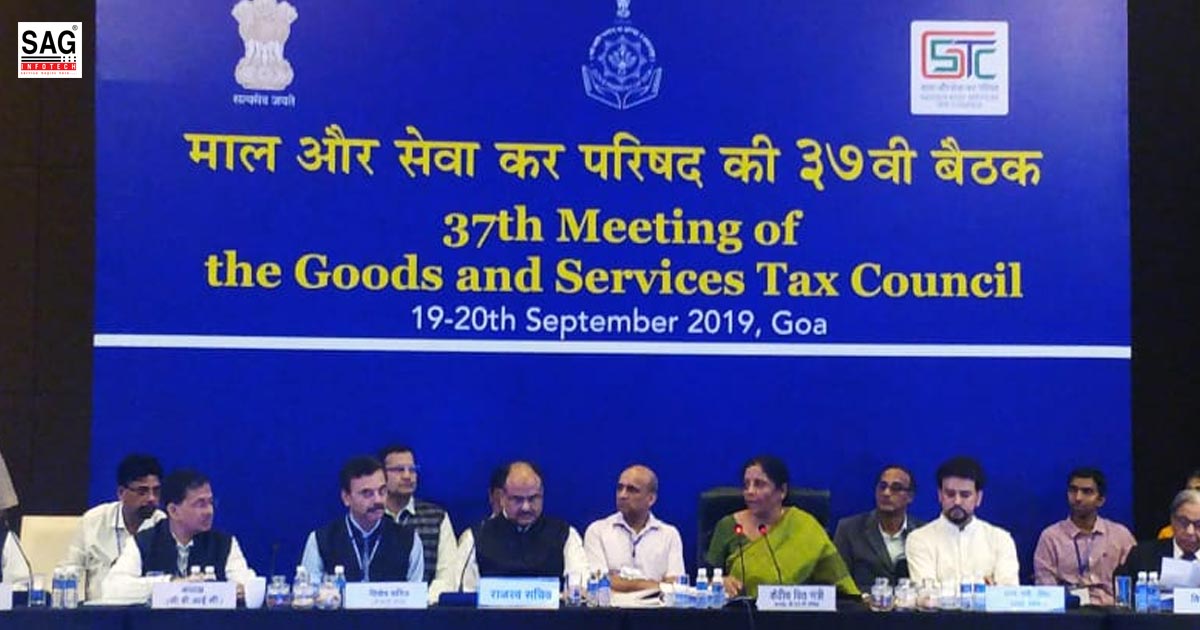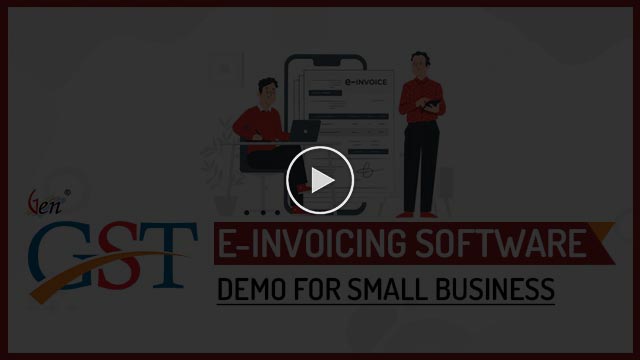
What is GST E-Invoice System?
GST e-invoice is the introduction of the digital invoice for goods and services provided by the business firm generated at the government GST portal. The concept of a GST e-invoice generation system has been taken into consideration for the reduction in GST evasion.
The GST officers have come to a conclusion by providing the businesses with a system through which it will become mandatory for them to generate ‘e-invoice’ for every sale on the government GST portal. This system will only be applicable to those whose turnover threshold is above the determined limit i.e. the government will set a threshold limit for them.
An official said that the businesses that will fall under a certain threshold will be given a unique number whenever an e-invoice will be generated. The businesses can match this number with the invoices which are written in the sales return and paid taxes for verification.
Latest Update for E-invoicing Under GST
- Updated advisory for AATO on NIC IRP Portal. read more
- “For taxpayers having a turnover above 20 crores, Multi-Factor Authentication (MFA) will be mandatory from 1st January 2025” View more
- The new advisory related to imposing the time limit on reporting old invoices at the IRP portal for AATO 10 Crores and above. View more
- 54th GST Council Meeting – The GST Council rolled out a pilot for B2C GST e-invoicing to verify the invoice reporting process for tax returns.
- According to the new advisory, a GST E-invoice is mandatory if the taxpayer’s turnover exceeds INR 5 crores in FY 2023-24. Read More
- The GSTN has enhanced the e-invoicing process and launched an enhanced version of the e-invoice portal (https://einvoice.gst.gov.in). View more
- Are you interested in learning about the e-Invoice Exemption Declaration functionality? This feature allows businesses to declare their exemption from e-invoicing and continue to generate invoices in the traditional format. See the video for more details.
- Are you interested in learning more about how to utilise the e-Invoice JSON Download feature? This functionality holds valuable information that can help streamline your invoicing process and optimise your business operations. Click for video
- For taxpayers with AATO of 5Cr and above, a 6-digit HSN will be mandatory on e-invoices on December 15, 2023. View more
- The GST department has enabled the new functionality for downloading e-Invoice JSON on the official portal. View More, Read PDF
- The B2B e-Invoices must be generated by taxpayers supplying to government departments/agencies using the GSTIN of the department or agency. Read more
- From 1st November 2023, two-factor authentication will be mandatory for all taxpayers with AATO over Rs 20 Cr.
- From 1st November 2023, taxpayers with an AATO greater than or equal to 100 crores and who use e-invoice portals will be subject to a 30-day time limit for reporting invoices. Read PDF
- From September 01, 2023, an invoice incentive scheme will be launched in Haryana, Assam, Gujarat, and the Union Territories (UT) of Dadra & Nagar Haveli, Daman & Diu, and Puducherry. View more
- The new e-invoice exemption declaration functionality is now live on the official GST portal for taxpayers. View more
- “Update on Enablement Status for Taxpayers for e-Invoicing” Read More
Need Demo of GST e-invoice Generation Software
No Physical GST Invoice Required When E-invoice Provided
The Central Board of Indirect Taxes and Customs (CBIC) refined that the physical invoice is not required to be carried when an e-invoice has been provided. The board has opted the representation upon the problem that carrying a physical copy of the invoice is essential upon the transportation of the goods in the case where the supplier has provided the invoices under GST in the way mentioned beneath rule 48(4) of the CGST Rules, 2017 (i.e. in cases of e-invoice).
How Can Businesses Be Maintained with GST E-invoice?
In some former years, the technology has brought out important amendments towards the management of accounting. Digital accounting had furnished the process easier in filing taxes and is free from error. Invoicing is also converted digitally, the accounting has specifically gets transformed. The invoices assist the companies in monitoring the businesses in their sales and maintaining the records of their finances.
Beneath the GST structure, e-invoice is an electronic authentication method. The GST officials have been allowed to execute the e-invoices by adopting the Invoice Registration Portal (IRP) for reporting B2B invoices enrolled with the departmental portal. This ensures the companies timely report the B2B invoices which are to get enrolled and verified on the GST portal or GSTN portal. The e-invoicing is supporting the twin feature of monitoring the B2B transactions and rectifying the GST compliance.
Mechanism Linked in GST E-Invoicing
The most efficient way to generate invoices online is e-invoicing. It just automates the complete procedure and removes the requirement of the human. The seller generates the invoice and provides directly to the server of the purchaser. Through this step, the system of the purchaser is enabled to use the invoice as needed through the company and subsequently takes the permission and payment.
In such a time the companies are switching to remote working and shall require to think again that in which the invoice is presently handling. The office-based support from the team towards manual processing of the incoming invoices is sent through email or post. But the remote team does not satisfied with this purpose as every person is working from distinct locations. It is the object in which the GST e-invoice plays the essential role in furnishing the transition to remote working smooth and its sustenance enables for the companies.
Paper invoices approaching is a big issue when the team is working remotely. “E-invoicing is being extensively used across the globe. Services and standards of accounting software are evolving continuously and improving further. Clearly, the benefits of e-invoicing for the purposes of managing remote teams outweigh the disadvantages. By shifting from a paper process, a business can smoothly and seamlessly transition to remote working while maximising productivity and performance,” a tax expert said.
Bigger Advantages for Accounting Software Furnished are
Check Real-Time: Automated alerts in real-time give the assurance to every individual upon the team knows exactly what is needed. It eliminates the loss of invoices and assists in maintaining performance.
Reporting Tools of Integrated: Complete invoice-related details can be quickly accessed by the employees who work from home through exercising the integrated reporting functions. Through the older method, the reports take much time which can now be generated in minutes.
Compliance Safeguards: through effective management, the remotely working team can indeed eliminate the risks held through human errors. The automated checks can find out the potential threats and issues such as mismatched company items or duplication of invoices
Applicability of GST E-Invoice System
It will be mandatory for the businesses to generate the entire GST e-invoice including all the value of sales. The assessee whose turnover is more than Rs 500 crore in the previous fiscal year from 2017-18. (Notification No. 13/2020 Dated 21/03/2020), Rs.100Cr From 01/01/21 to 31/03/21 (Notification No. 88/2020 Dated 10/11/2020), Rs.50Cr From 01/04/21 to 31/03/22 (Notification No. 05/2021 Dated 08/03/2021) & Rs.20Cr From 01/04/22 Onwards (Notification No. 01/2022 Dated 24/02/2022).
Privileged Sectors: SEZ units, Insurance banking, which consists of NBFCs, cinema admissions, dealership of goods transport who carries goods via roads, and passenger transport services.
Benefits of GST E-Invoices
- Simplified GST compliance
- Precision
- Lesser reconciliation errors
- Reduction in price
- abolition of paper
- The effective functioning of capital performance
- Improvement in business efficiency
Thus it is Not the Soft Copy of GST Invoices
- E-invoice is not just about invoice displayed in the soft copy like PDF etc
- Indeed the e-invoice does not mean to generate the invoice through the government portal
GST e-Invoicing Trial Version Released
The government has finally launched the GST e-invoicing trial version of the popular invoicing mechanism which was earlier discussed in the GST council meeting. The GST e-invoicing will provide multiple categories under which the taxpayer will fill the e-invoice as per the turnover and other criteria. It is required for every taxpayer to have a turnover of more than 500 crores to fill GST e-invoicing through the government portal itself.
E-Invoicing Under GST Time Period with Business Turnover Conditions
- Turnover More Than 500 Crores – Start from 1st October 2020
Note:
- “The roll out of e-invoicing is set to come from 1st Oct onwards relevant to the companies having turnover more than 500 crs”.
- “Seeks to exempt certain class of registered persons capturing dynamic QR code and the date for implementation of QR Code to be extended to 01.10.2020”. Read Notification
- “Seeks to exempt certain class of registered persons from issuing e-invoices and the date for implementation of e-invoicing extended to 01.10.2020”. Read Notification
- GST e-invoicing is mandatory from 1st October 2020 for the above businesses. Those with turnover up to 100 Crore, voluntary and trial basis start from 1st October 2020 as per the sources. Read Official Press Release.
- w.e.f 1st October 2020, a supplier whose aggregate turnover in a financial year exceeds 500 crore rupees, to an unregistered person (B2C Invoice), shall have quick response (QR) code.
The official also gave an example in which if Rs 1,000 is the fixed minimum invoice then there are high chances that the businesses can divide the bills so that they can avoid the invoice which will be generated because of the threshold.
Major Challenges of E-invoicing Under GST
- If the invoice is found not registered on the IRP, such invoice will not be considered as a valid tax invoice for all GST related matters and hence a penalty of ₹ 10,000 will be incurred for each instance of non-compliance
- Transportation of goods without a valid tax invoice can be a reason for the detention of goods and vehicles and fines will be also imposed
- Customers may deny accepting and/or pay goods if a valid tax invoice is not available as this would affect the receiver’s eligibility to receive ITC benefits
- In addition, the government plans to implant a check that will prohibit the generation of an e-way bill if the IRN is absent
The Process to Generate GST E-Invoice
The process of generating the GST e-invoice will be the same as the e-way bill which is generated on the https://ewaybill.nic.in/ portal or the GST payments done on the GSTN portal.
The system for generating the GST e-invoice will replace the e-way bill that is being generated for the movements of goods because the generation of invoices will be done by a centralized government portal. At present, the e-way bill is generated only for those moving goods which cost more than Rs 50,000.
The official also added that after the e-tax invoice generation system kicks off then there will be no tension for businesses to file the GST returns 
The official further added, “We will have to study global models followed by countries like Latin America, South Korea, and Europe. We will also look at ways to incentivize businesses to adopt the method of e-invoice generation”.
Along with the officers committee, the state, central tax officials and GST Network Chief Executive are altogether given the responsibility to introduce the e-invoice under the GST system in order to reduce the invoice generation and compliance burden. The committee is given a deadline for finalising the interim report by next month.
The main aim of e-invoice generation is to check GST evasion. After two years of rollout of GST, the government is now aiming towards anti-evasion measures to increase revenue as well as compliance.
From the 1.21 crore registered businesses, only 20 lakh comes under the composition scheme.
According to a tax expert, the GST e-invoice generation system will reduce the double efforts as well as the manual involvement in the tax returns filing and checking.
It said, “To incentivize businesses to adopt the new system, the tax department could limit the frequency of mandatory departmental audits in case procurements are made on basis of e-invoices”.
IRPs’ Role Under GST E-invoicing
After arrays of discussions, E-invoicing has finally been implemented from 1 January on a voluntary basis for GST registered businesses in India. E-invoicing or electronic invoicing is introduced basically to report B2B invoices to the GST system in an organized manner. Apart from that, the real-time reporting of transaction invoices will eliminate the chances of last moment hassles due to pendency.
Purpose of IRPs
- IRP – the first Invoice Registration Portal allows invoice registration on the GST system through API mode in addition to other modes.
- IRP helps to integrate its e-invoicing system into the taxpayer’s business invoicing system.
- The portal even helps the taxpayer to get the credentials through which he can access APIs. Registration for API access is complete once the OTP sent on the verified mobile number and email id is entered.
- IRP provides details related to integrating the business systems to their e-invoice systems through APIs.
- Code extracts and master data are provided to have proper knowledge of logic and concepts.
- With the help of the portal, developers can improve the performance of APIs by understanding and testing the API methods.
New Update for E-invoicing Under GST System
Adding to the enhancement of GST structure, the council has currently made a move to legitimate a new GST E-invoicing or electronic invoicing in a channelized way for reporting business to business (B2B) supplies to the GST system. The provision will be in practice from 1 January 2020 on a voluntary basis. Every new provision calls for fixing a particular standard to practically achieve the goal. The basic standard for e-invoicing is finalized after discussions with trade/industry bodies and members of ICAI to ensure the absolute applicability of the new e-invoicing under the GST system. Till now there was no standard fixed for e-invoicing.
The functioning of e-invoicing is directed in such a way that e-invoices generated by one software are operative by another software eliminating the need to re-enter the digits for a fresh entry. Adoption of this particular standard will allow the seller, buyer, bank or agent or any other concerned person to read by machine and restrain the unnecessary data hence eliminating errors. This is the key objective behind changing the structure of the e-invoicing GST.
It was in the 37th GST council meeting 
General Queries on GST E-Invoice System
Q.1 – What do we mean by GST e-Invoicing?
If we talk about e-invoicing, E stands for ‘Electronic’ which clearly indicates the involvement of computers while generating an invoice. Simply, e-invoicing is a technique under which invoices are electronically generated in a prescribed format and the GST invoice information thus obtained can be circulated electronically within the group of concerned individuals. The invoice information gets saved in the software cutting down the need for fresh entries.
Q.2 – How does e-Invoicing architecture work?
- Businesses are required to generate an electronic invoice on every sale on their respective ERPs. Creating an e-invoice is the prior responsibility of the taxpayer (dealer)
- The standard invoice format if pre-fixed by authorities for every business. So that proper details are extracted
- The e-invoice thus generated needs to be reported to the Invoice Registration Portal (IRP) of GST
- On the portal, the Invoice Reference Number (IRN) will be generated and the invoice will be signed digitally
- Then a QR code will be generated. The code contains all the vital information related to the invoices which will be re-directed to the taxpayer who filed the invoices
- The IRP will send a copy of the signed invoices to the provided email id of the recipient of supply who is engaged in the whole process
Q.3 – What documents are required while reporting in IRP?
- Supplier side invoices
- Supplier’s Credit Notes
- Recipient’s Debit Notes
- Other documents except once mentioned above (if required by law).
Q.4 – In which year e-invoicing will come in effect in India?
The provision of e-invoicing will be effective from October 2020 all over the nation.
Q.5 – Which genre of taxpayers will come under the umbrella of e-invoicing compliance?
For now, the provision is said to be introduced on a voluntary basis. After looking at the results of this provision and the convenience level of the taxpayer, the mandatory levy of the law will be applied to all taxpayers with annual turnover above a certain limit. Subsequently, the motive of the law is to bring all the taxpayers (category wise) under the ambit of the law.
Q.6 – How will the e-Invoicing mechanism get merged with the GST Return system?
The invoices will get auto-populated on the relevant GST return once they are signed and verified by the invoice registration system. Once document verification is done, the invoices will get directed to the recipient of supply for re-confirmation (as directed by the new invoicing law). The prime objective of the law is to auto-populate the taxpayer’s invoice details to his GST returns and reduce the chances of errors while reconciliation.
To be noted: Once the invoice data is verified the information gets auto-populated in the respective taxpayer’s GST returns, thus eliminating the need to re-enter the digits.
Q.7 – In which countries (other than India) e-invoicing system is practised?
Countries (other than India) like Mexico, Sweden, Turkey, Italy, South Korea, Brazil, Chile, Peru, Denmark, etc. have already embraced the e-invoicing as an integral part of their taxation system.
Q.8 – How does an e-Invoice appear to businesses?
There is a standard e-invoice format for all the businesses operating in India. Every business is obliged to abide by the single format assigned by authorities.
Q.9 – How is e-invoicing system beneficial for businesses as well as tax authorities?
- B2B invoices are recorded for once eliminating the need to report the bill in multiple formats and ultimately reducing the chances of errors
- There will be a proper record of overall Sales and Purchase of a business and as a result, the GST returns will automatically be ready for filing under the new GST system
- E-way bills can be created using the e-Invoice details
- There are fewer chances of data reconciliation between the books and filed GST returns
- Real-time invoice entry from the supplier’s side will lead to faster processing of input tax credit on the recipient’s side resulting in faster and accurate credit availability to the recipient
- Auto-loaded information helps the taxpayer in an easy filing with a shorter pile of compliance documents
- Less instance of tax evasion and fraud as the new process asks for real-time data entries
- No possibility of creating fake GST invoice.
Q.10 – What are the features of newly introduced e-invoicing software and how it will help businesses to accurately file their tax compliance?
GSTN and ICAI collaborated to design the standard format of e-invoice for businesses operating in India. This refers to PEPPOL (Pan European Public Procurement Online), which is based on the UBL (Universal Business Language) standard. The software focuses on the prevailing tax laws and even incorporate features supporting international trade. The information required by the government on a primary basis is marked as mandatory in the e-invoice others are marked as optional fields in the form.
Q.11 – What are the contents of the proposed e-invoice format?
- E-invoice schemes – The section incorporates technical field name and the description of each field. It also indicates the significance of each field whether it is important or not. Apart from that other important aspects are mentioned in the section
- Masters – Masters monitor the set of details which will be entered in certain fields that are pre-decided by the GSTN itself. The fields include UQC, State Code, invoice type, supply type, etc
- E-Invoice template – The e-invoicing template helps teh reader to co-relate the terms used in other sheets. The mandatory terms are marked in green and non-mandatory in yellow
Q.12 – Is there one single format for all genre of taxpayers or the format is different for different taxpayers?
The e-invoice legalized by the government has the same format for all the businesses running in India. The designated e-invoice format has all the mandatory fields of transaction details required by the government.
Q.13 – Does GST portal support e-invoice generation?
There is no such mechanism of generating e-invoice directly on the GST portal. Some companies have already hired the individual ERP for e-invoicing task. Business invoices should be in line with the protocols set for invoicing. Invoice generation directly on the giant portal (GST Portal) is not been suggested for now. Small and medium businesses can take help from eight free accounting/billing softwares currently listed by the GSTN.
Q.14 – Is there a limit for incorporating line items in each e-invoice?
Yes, the maximum of 100 items can be incorporated in each e-invoice.
Q.15 – Is it mandatory for the supplier to digitally sign the e-invoice again?
There is no need for the supplier to digitally sign the e-invoice which is to be uploaded on IRP. The e-invoice will automatically get signed after validation.
Q.16 – Is it possible for businesses to mark their firm logo on the e-invoice template?
No, businesses cannot incorporate their firm logos in the e-invoice as the standard invoice format is designated to all the companies in India and no space is assigned for the firm logo. However, companies are allowed to put their logo on accounting and billing documents but these will not be visible on the IRP.
Q.17 – Is there a facility of bulk invoicing in IRP?
There is no facility as such. The taxpayer needs to upload one invoice at a time into IRP. The company’s ERP needs to be organised in such a way that it places one invoice upload request at a time.
Q.18 – What are the various ways of getting e-invoices registered on Invoice Registration Portal (IRP)?
Multiple modes will be made available for getting e-Invoices registered on the Invoice Registration Portal (IRP). Some of the proposed modes are- The ways to get e-invoice registered on the Invoice Registration Portal (IRP) are: Website, API, SMS, Mobile app, Offline tool and GST Suvidha Provider (GSP).
Q.19 – Within how many days will the entered data on government portal get expired?
The information entered on the IRP will expire after 24 hours of entry. The registered and verified invoices will get automatically uploaded into the respective GST return and it will be there for the whole financial year.
Q.20 – Is it possible to partially/fully cancel the e-invoice?
There is no way to partially cancel an e-invoice. The e-invoice once created can be fully cancelled. The cancelled invoice should further be reported to IRN within 24 hours of cancellation and should manually be cancelled on the GST portal before the returns are filed.
Q.21 – Is it possible to make changes in an e-invoice?
Yes, it is possible to make changes in the e-invoice only the details are uploaded in GST returns.
